Start your perfume-making journey with five essential fragrance families: soliflore, floral amber, floral bouquet, floral fresh, and floral green. You'll want to begin with single-flower compositions before moving to classic pairings like rose with jasmine or lavender. For balanced blends, follow the 30-50-20 ratio of top, middle, and base notes. Let your creations rest for several days to develop their true character. Discover how seasonal elements can transform your signature scent.
Essential Flower Families for Beginner Perfumers
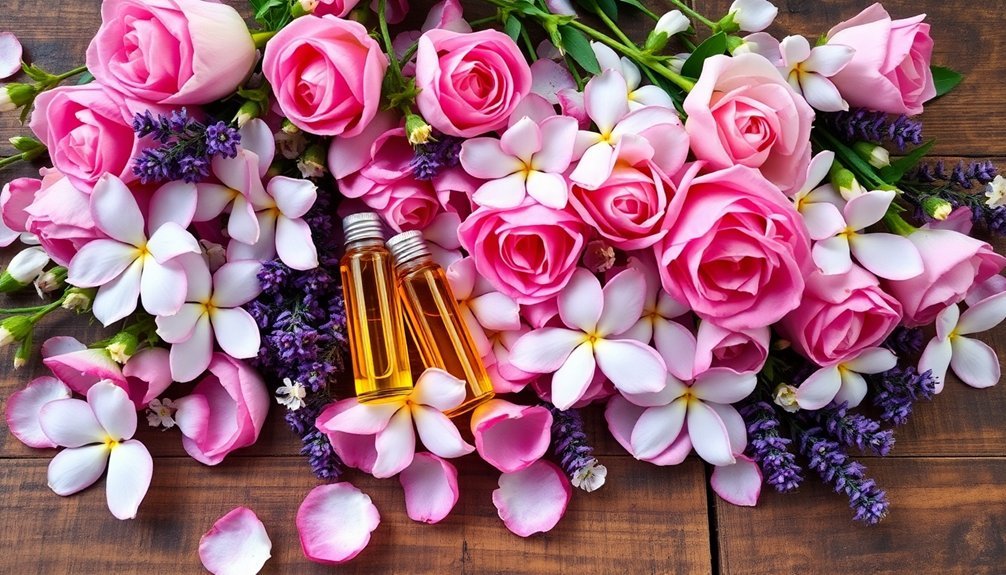
Five core floral fragrance families form the foundation for beginner perfumers: soliflore, floral amber, floral bouquet, floral fresh, and floral green.
If you're just starting out, you'll want to focus on soliflore compositions first, as they highlight a single flower's character, like Diorissimo's lily-of-the-valley note.
Once you've mastered single notes, try creating floral bouquets by combining classic flowers like rose, jasmine, and peony. Exploring these combinations helps build a foundational tool for understanding fragrance composition.
For a modern twist, experiment with floral fresh blends using citrus notes, similar to Tom Ford's Neroli Portofino.
When you're ready for more complexity, explore floral amber's rich, spicy combinations or floral green's cool, dewy impressions of leaves and moss.
These families will give you a solid understanding of how different floral notes interact and complement each other.
Starting With Simple Rose-Based Combinations
When beginning your journey into floral perfume combinations, rose fragrances offer an ideal starting point due to their versatility and universal appeal. You'll find that Diptyque Eau Rose, with its blend of Damask and Centifolia roses, creates an excellent foundation for experimenting with different scent combinations. Its balanced floral heart makes it particularly adaptable when creating unique fragrance blends.
| Rose Pairing | Effect |
|---|---|
| Wood Sage & Sea Salt | Fresh, mineral-driven contrast |
| Philosykos | Enhanced natural, green notes |
| Gypsy Water | Earthy, resinous depth |
| Musc Ravageur | Warm, sensual intensity |
| Santal 33 | Leathery, smoky edge |
Try starting with lighter combinations for daytime wear by layering citrus notes, then progress to deeper, more complex blends for evening using woody or spicy fragrances. The key is to start with small amounts and adjust according to your preferences.
Creating Balanced Jasmine and Lavender Blends
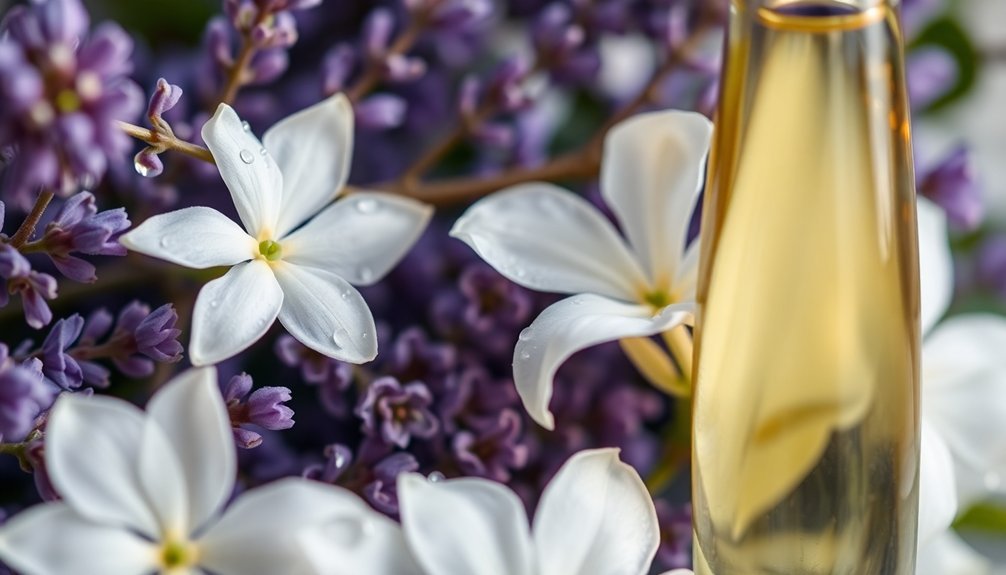
Creating balanced jasmine and lavender blends requires a thoughtful understanding of their distinct aroma strengths and characteristics. Since jasmine has a stronger aroma presence, you'll want to use it sparingly compared to lavender. Your personal fragrance preferences vary based on your unique memories and associations with these scents.
Start with a ratio of 4-8 drops of lavender to 1 drop of jasmine, then adjust according to your preferences.
- Test your blend using aroma wands or blotter strips to assess the harmony between these floral notes.
- Consider adding complementary herbal notes like basil or rosemary for depth and freshness.
- Ground your blend with base notes such as vetiver to prevent the scent from being too light.
When blending, remember that jasmine acts as a middle to base note, while lavender sits in the middle range.
You can adjust these ratios as you experiment, using the fragrance blending wheel as your guide.
Seasonal Flower Scent Pairings That Work
The art of seasonal flower scent pairings reflects nature's shifting aromatics throughout the year.
In spring, you'll find success combining blood orange and grapefruit with vanilla and sandalwood, or blending mandarine orange with freesia and lily of the valley. These revitalizing, citrusy combinations capture spring's awakening energy.
For summer fragrances, you'll want to embrace lighter, airier notes.
Try honeysuckle with cherry blossom and bluebells, or combine peony with soft, sweet undertones. You can also create invigorating oceanic blends by mixing sea salt with lemongrass or adding sea minerals to fennel.
Each season calls for different base notes: spring favors woody foundations like sandalwood, while summer works well with lighter bases like white musk or amber.
Remember to balance stronger notes with complementary lighter ones.
Understanding Floral Notes and Their Intensity
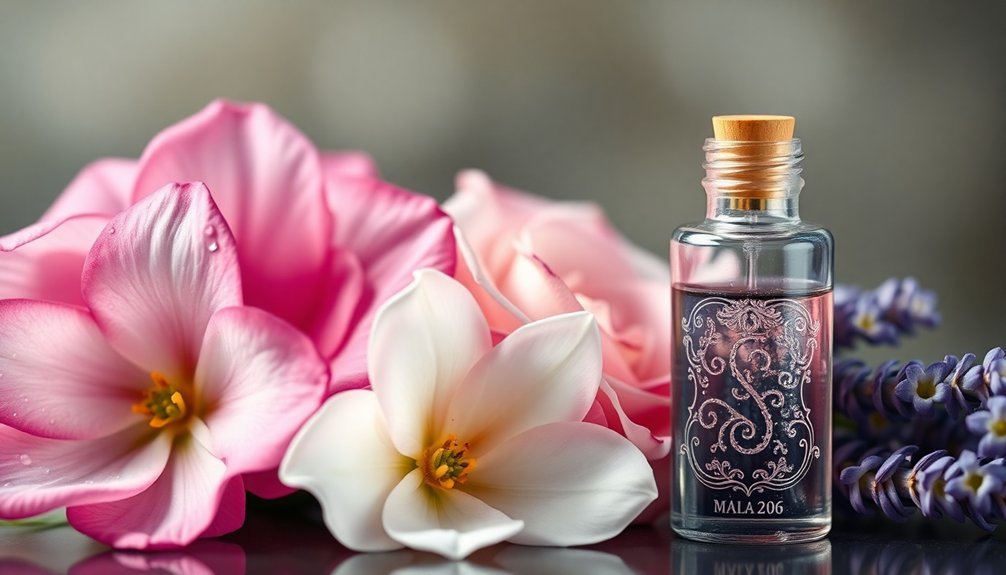
Building on our seasonal pairings, let's explore the rich world of floral notes themselves. When you're working with floral fragrances, you'll discover they can range from whisper-soft to boldly intense. These notes typically emerge after the initial burst of top notes fades, lasting anywhere from a few to several hours on your skin.
You'll find three main intensity levels in floral notes:
- Light and delicate – think fresh peony or soft lily
- Medium and balanced – like classic rose or powdery violet
- Rich and potent – such as heady jasmine or intoxicating gardenia
To create depth in your blends, try combining different intensities with complementary notes. Pair lighter florals with citrus for freshness, or ground deeper floral notes with woody or musky bases for lasting power.
Complementary Non-Floral Elements for Your Mix
When creating your floral perfume, you'll want to take into account three key companion elements that can transform your blend.
Citrus notes like lemon and bergamot cut through heavy florals to create an airy, fresh scent, while woody bases such as cedarwood and sandalwood anchor your blooms with lasting power.
You can also warm up your floral mix by incorporating spices and oriental notes, which add rich depth and complexity to your fragrance.
Citrus Brightens Floral Notes
Adding citrus notes to your floral perfume creates a vibrant and harmonious blend that elevates the entire fragrance profile. When you layer citrus with florals, you'll enhance the freshness while adding depth and balance to your scent.
Popular combinations like bergamot with jasmine or lemon with rose can transform your perfume into a more sophisticated creation.
To successfully blend citrus and floral notes:
- Start with your chosen floral base, then layer citrus on top
- Apply both scents to well-moisturized skin for better longevity
- Test combinations on a separate surface before wearing
You'll find that citrus notes like bergamot, lemon, or grapefruit can cut through the sweetness of florals while extending their staying power. This brightening effect creates a more versatile fragrance that's suitable for any occasion.
Woody Base Anchors Blooms
To create a lasting floral fragrance that captivates throughout the day, woody base notes serve as essential anchors for your blooming scents.
You'll find that woods like sandalwood and cedarwood provide the perfect foundation, extending your perfume's longevity while adding sophisticated depth.
Different woody notes offer unique effects: dry woods like vetiver bring earthy elegance, while creamy sandalwood adds a soft, milky touch.
For a rich, slightly sweet undertone, try incorporating mossy woods like patchouli. If you're aiming for an exotic blend, consider oud's smoky, animalic qualities.
The key is finding the right balance.
Start with lighter woods in spring-summer blends and warmer, more intense woods for fall-winter fragrances.
You'll discover that woody bases don't just support your florals—they transform them into complex, enduring compositions.
Spices Add Warm Depth
Spices bring an irresistible warmth to floral perfumes, transforming delicate blooms into rich, multidimensional scents. To achieve this depth, you'll want to explore classic spicy flower combinations like carnation blended with clove and vanillin, or the distinctive curry-like notes of immortal flower paired with honey undertones.
When crafting your blend, remember these key spicy elements:
- Eugenol from cloves adds smoky, woody complexity
- Benzyl salicylate creates a sun-kissed, balsamic warmth
- Saffron introduces leathery, dark nuances with honeyed touches
Start with light, fresh florals as your foundation, then gradually layer in spicier notes.
You'll find this approach particularly effective in fall and winter fragrances, where the added warmth creates an enveloping, sophisticated character that lingers beautifully.
Crafting Your Signature Floral Blend
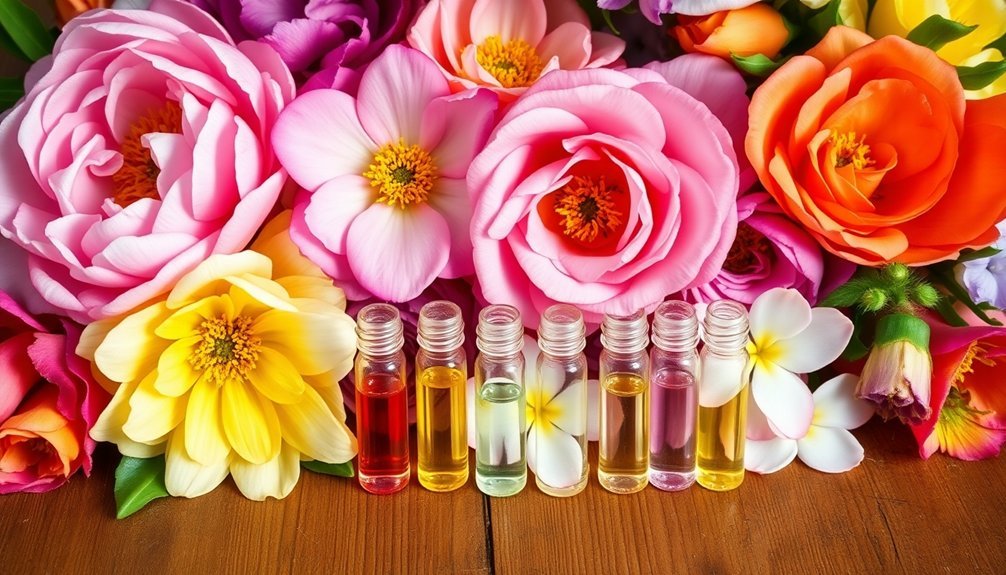
You'll find endless possibilities when combining floral notes like jasmine and rose for your signature scent, with each pairing creating unique aromatic stories.
For seasonal depth, try layering spring flowers like lilac with summer blooms such as gardenia, adjusting the ratios to achieve your perfect balance.
Your signature blend comes alive as you experiment with fragrance family proportions, testing how much floral intensity works best against your chosen base notes.
Essential Floral Note Combinations
Creating a signature floral blend requires understanding how different flower essences interact and complement each other.
You'll find that certain combinations consistently produce enchanting results, while others enhance each note's unique characteristics.
Classic pairings like rose and jasmine create timeless luxury, while rose and lavender offer a harmonious feminine touch.
For a more contemporary approach, you can experiment with these proven combinations:
- Jasmine and ylang-ylang for an exotic, sweet aroma that's both fresh and ethereal
- Rose and sandalwood to achieve depth and sophistication in your blend
- Lavender and pepper to create an intriguing balance of soothing and spicy notes
When crafting your blend, consider starting with these foundational combinations and gradually incorporating complementary notes like fruits, woods, or spices to develop your unique signature scent.
Layering Seasonal Flower Scents
While many fragrance enthusiasts focus on single scents, mastering the art of layering seasonal flower scents can transform your signature blend throughout the year.
During spring and summer, start with light floral bases like gardenia or rose, then add citrus notes for brightness. You'll want to pair Secret Gardenia with Hydra Figue for a fresh, cooling effect.
As temperatures drop, shift to deeper floral combinations. Try layering Peau Santal over Étui Noir for warmth, or blend Myrica Muse with Black Datura for a complex winter profile.
Remember that warm weather amplifies fragrances, while cold weather mutes them. For best results, apply lighter scents first and allow them to dry before adding stronger notes.
Don't layer more than three fragrances, and use the fragrance wheel to select complementary combinations.
Balancing Fragrance Family Ratios
Before diving into floral blending, understanding the ideal ratios between fragrance families will guarantee your custom perfume maintains its balance throughout the day.
For beginners, start with a 30-50-20 ratio: 30% top notes for initial impact, 50% middle notes for the main character, and 20% base notes for longevity.
When crafting your signature floral blend, keep these essential guidelines in mind:
- Begin with the drop-by-drop method, carefully documenting each addition to replicate successful combinations.
- Let your blend rest for several days, allowing the fragrances to meld and develop their true character.
- Test different ratios based on your preference – you might prefer the classic 3:2:1 for a more top-note-dominant blend.
Frequently Asked Questions
How Long Do Homemade Flower Perfumes Typically Last Before Expiring?
Your homemade flower perfume's shelf life depends on its base. You'll get 3-5 years from alcohol-based blends, while oil-based ones last about a year when stored properly in cool, dark places.
Can I Use Dried Flowers Instead of Fresh Ones for Making Perfume?
You can use dried flowers, but they'll have weaker fragrances than fresh ones. While they're more stable and convenient to store, you'll need more dried flowers to achieve the same intensity as fresh blooms.
What Equipment Is Essential for Beginning Perfume Making at Home?
You'll need glass bowls, measuring droppers, dark storage bottles, labels, and precise scales. Don't forget vital mixing tools like pipettes and funnels. A quality perfumer's alcohol is also important for dilution.
Are There Any Flowers Commonly Used in Perfumery That Can Cause Allergies?
Yes, you'll need to be careful with roses, lilies, carnations, and hyacinth, as they contain common allergens like linalool and geraniol. These flowers can trigger allergic reactions through skin contact or inhalation.
How Can I Preserve the Scent of My Garden Flowers for Perfume Making?
You can preserve garden flower scents through alcohol infusion, oil extraction, or the traditional enfleurage method. Harvest flowers at peak fragrance, then store your finished perfume in dark glass bottles away from light.
In Summary
Now that you've learned the basics of flower perfume blending, you're ready to create your own signature scent. Start with simple pairings, trust your nose, and don't be afraid to experiment. Remember to keep track of your successful combinations and learn from the ones that didn't work. With practice and patience, you'll develop the confidence to craft unique floral fragrances that truly express your personal style.
References
- https://maisondabba.com/blogs/avant-garde-perfumery-wave/a-comprehensive-guide-to-perfume-blending-for-all
- https://www.belayered.com/blogs/blog/how-do-you-make-perfume-with-flowers
- https://woopdiy.com/blogs/news/essential-oil-perfume-recipes-guide
- https://mockingbirdapothecary.com/blogs/mockingbird-blog/crafting-perfect-scents-an-essential-oils-blending-guide-for-beginners
- https://www.soapguild.org/tools-and-resources/resource-center/73/beginners-guide-to-fragrance-blending/
- https://witandwest.com/blogs/wit-west-blog-field-notes/overview-of-the-different-fragrance-families
- https://www.ftd.com/blog/floral-perfumes
- https://www.sylvaine-delacourte.com/en-us/guide/the-floral-family
- https://versatileparis.com/en-ww/blogs/les-essentiels/famille-olfactive-florale
- https://www.navarose.com/2024/08/top-layering-partners-for-diptyque-eau-rose.html
- https://basenotes.com/community/threads/what-would-you-layer-with-a-rose-fragrance-to-make-it-more-masculine.270442/
- https://basenotes.com/community/threads/rose-accord-compendium-a-beginners-guide.543959/
- https://scentsandsensibilities.co/2023/07/03/notes-on-notes-rose/
- https://www.pinterest.com/ideas/scent-combos-rose/917535586666/
- https://achs.edu/blog/blending-101-the-art-of-pairing/
- https://lightandcalm.com/products/harmonious-balance-aromatherapy-candle-lavender-jasmine-cedarwood-blend
- https://www.rareessencearomatherapy.com/shop/essential-oils/aromatherapy-roll-on/womens-balance-organic-aromatherapy-roll-on/
- https://www.candlescience.com/learning/fragrance-oil-blending-101/
- https://inlovewithcolour.com/2023/10/25/fragrances-for-the-seasons-and-clothing-personalities/
- https://www.zents.com/our-favorite-layered-fragrance-combos-for-spring/

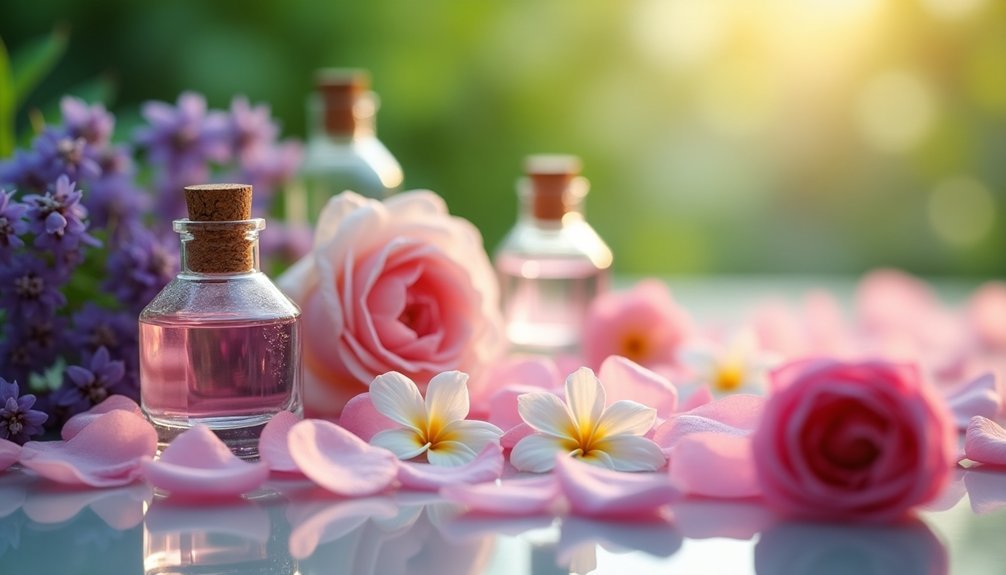



Leave a Reply